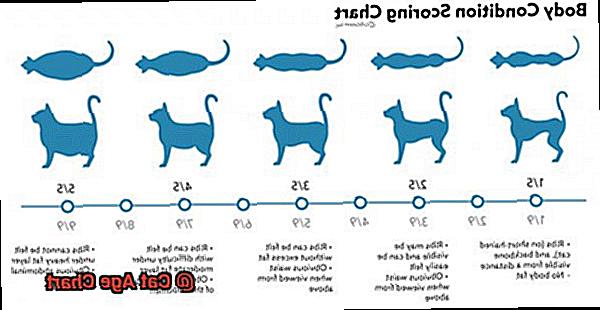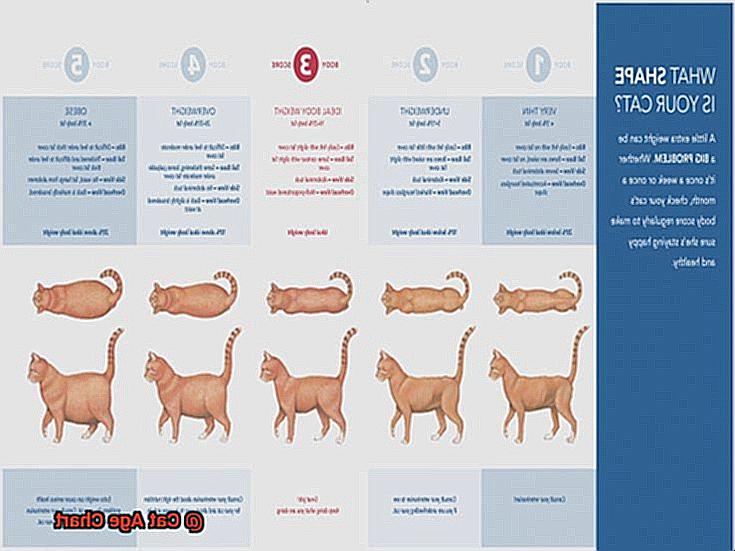Cats are beloved pets around the world, but have you ever stopped to think about how their age compares to human years? It’s an important consideration because understanding your cat’s age can help you provide better care and extend their lifespan. Luckily, the Cat Age Chart (in Human Years) can help you make sense of it all.
But don’t be fooled into thinking that calculating your cat’s age is as simple as multiplying by seven. Did you know that a four-year-old cat is equivalent to a 32-year-old human? Or that a 10-year-old cat is more like a 56-year-old person? The Cat Age Chart takes these factors into account and helps you understand where your furry friend falls on the aging spectrum.
In this blog post, I’ll guide you through the ins and outs of the Cat Age Chart (in Human Years). You’ll learn how to use it to gain insight into your cat’s current stage of life, and I’ll share tips for keeping your feline companion healthy and happy throughout their lifetime. So let’s dive in and explore this fascinating topic.

What is the Cat Age Chart?

Fortunately, the Cat Age Chart (in Human Years) is here to help you find out. This tool compares your cat’s age to a human’s age, giving you an estimate of their equivalent age in terms of human years.

The Cat Age Chart is based on the fact that cats age differently than humans. For example, a one-year-old cat is equivalent to around 15 human years, while a two-year-old cat is closer to 24 human years. And for every additional year, you can add four more human years to calculate their equivalent age.
But don’t forget – this chart is just an estimate. There are many individual factors that can contribute to your cat’s lifespan and overall health, such as genetics, breed, and lifestyle. For instance, indoor cats often live longer than outdoor cats as they’re less likely to suffer from accidents or illnesses.

The Cat Age Chart is divided into two categories: kitten and adult. Kittens are considered one year old when they’re born and reach maturity at around six months old. After that, they’re classified as adults.
Despite its limitations, the Cat Age Chart can still be a valuable resource for cat owners. It can help you understand your cat’s aging process and anticipate any possible health issues that may arise as they grow older. Remember though, regular check-ups with your veterinarian are still essential regardless of your cat’s estimated age.
How to Use the Cat Age Chart
Many cat owners are curious about their cat’s age, and the Cat Age Chart is a helpful tool to estimate it. However, it’s important to remember that this chart is not an exact science and that there are several factors to consider when using it. Here are 5 sub-sections to help you understand how to use the Cat Age Chart and the important considerations to keep in mind:

Understanding the Chart
The Cat Age Chart compares a cat’s age to a human’s age, but it’s essential to understand how it works. The first year of a cat’s life is equivalent to 15 human years, and the second year is equivalent to 24 human years. After that, each additional year is equivalent to four human years. To use the chart, find your cat’s age in years and then look for the corresponding age in human years on the chart.
It’s Just an Estimation
While the Cat Age Chart can provide an approximation of your cat’s age, it’s essential to remember that every cat ages differently based on their individual genetics, lifestyle, and overall health. Therefore, you should use the chart as a general guideline rather than an exact science.
Adjusting Diet and Activity Level
As your cat ages, their dietary and activity needs may change. Senior cats may require different types of food and exercise routines to maintain their health and wellbeing. Consult with your veterinarian for specific recommendations on how best to care for your aging feline friend.
Monitoring Behavior and Health
In addition to using the Cat Age Chart, monitoring your cat’s behavior and health is crucial to ensure they receive proper care and attention. Regular check-ups with your veterinarian can help ensure your cat gets the care they need at every stage of their life.
Individual Factors
Finally, keep in mind that individual factors such as breed, genetics, or lifestyle can also affect a cat’s aging process. For example, some breeds of cats are known to live longer than others, and indoor cats tend to live longer than outdoor cats. Therefore, while the Cat Age Chart can be a useful tool, it’s crucial to consult with your veterinarian regularly to ensure your cat’s health needs are being met regardless of their estimated age.
Kitten vs Adult Cats
As someone who has devoted their career to understanding cats, I can tell you that kittens and adult cats have different needs and behaviors. Knowing these differences is key to providing them with the proper care they need to thrive. Kittens are typically aged between 0-6 months, while adult cats are over 6 months old.
Kittens require more attention and care than adult cats. They need frequent meals throughout the day and specialized kitten food that provides the necessary nutrients for their growth and development. Monitoring their litter box habits and ensuring they are properly socialized with humans and other animals is also important.
Adult cats, on the other hand, are more independent and self-sufficient. They typically eat less frequently than kittens and can be fed regular cat food. However, they still require regular veterinary check-ups and attention to their grooming needs.
Behavior-wise, kittens are often more energetic and playful than adult cats, who may be more laid-back and content with lounging around the house. Kittens also have a tendency to scratch and chew on objects, which can be addressed through providing appropriate scratching posts and chew toys.
But it’s important to remember that individual factors like breed, genetics, and lifestyle can affect a cat’s aging process. Adjusting their diet and activity level as they age, monitoring their behavior and health regularly, and consulting with your veterinarian for specific recommendations will ensure your cat gets the care they need at every stage of their life.
Examples of the Cat Age Chart
Look no further than the Cat Age Chart. This tool is essential for understanding how cats age differently than humans and estimating their age in human years.
For example, did you know that a one-year-old cat is approximately equivalent to a 15-year-old human? And a two-year-old cat is approximately equivalent to a 24-year-old human? As your cat ages, their equivalent human age increases much faster than ours. By the time your furry companion reaches 10 years old, they’re roughly equivalent to a 56-year-old human.
However, it’s important to remember that the Cat Age Chart is just a general guideline. Every cat ages differently depending on various factors like breed, diet, lifestyle, and genetics. Some cats may show signs of aging earlier or later than others.
To ensure your cat lives their best life, providing them with proper nutrition and exercise is crucial. Cats are natural hunters, so interactive toys and activities can stimulate their mind and body. Additionally, regular check-ups with your veterinarian are essential for detecting any health issues early on. Don’t forget about dental care either – just like humans, cats can suffer from dental problems.
Factors That Affect a Cat’s Age
Here, we will explore the different factors that affect a cat’s lifespan.
Genetics
Just like humans, cats inherit certain genetic traits from their parents that can affect their lifespan. Some cat breeds are more prone to certain health conditions than others. For example, Siamese cats have a higher risk of developing respiratory problems, while Persians are more susceptible to kidney disease. If you’re considering getting a purebred cat, it’s crucial to research the breed’s potential health issues before making a decision.
Environmental Factors
Environmental factors can also play a significant role in your cat’s lifespan. Exposure to toxins or pollutants can cause health problems that can shorten their life. Similarly, poor nutrition or a lack of exercise can also have a negative impact on your pet’s health and lifespan. To ensure your cat stays healthy and happy, give them a balanced diet with proper nutrition and plenty of opportunities for exercise.
Lifestyle
Your cat’s lifestyle can also affect their age and lifespan. Generally, indoor cats tend to live longer than outdoor cats due to the reduced risk of injury or illness from outdoor hazards such as cars, other animals, and exposure to diseases. Additionally, regular veterinary care and vaccinations can help prevent illnesses and catch health problems early on, which can contribute to a longer lifespan.
Consulting With Your Veterinarian About Your Cat’s Health Needs
And when it comes to their health, consulting with your veterinarian is crucial. Just like humans, cats require regular check-ups and preventative care to ensure they stay healthy and happy throughout their life. Your veterinarian is your trusted partner in providing personalized care for your kitty’s specific health needs.
When you take your cat for their routine veterinary visit, your veterinarian will perform a thorough physical examination of your furry friend. They’ll check their teeth, ears, eyes, and heart. They may also recommend blood work or other diagnostic tests to assess your cat’s overall health.
But it’s not just about the physical exam. Your veterinarian is also there to answer any questions you may have about your cat’s behavior or health. They can provide expert guidance on nutrition, exercise, and preventative care such as vaccinations and parasite control. So don’t hesitate to share any concerns you may have with them.
As your cat ages, their healthcare needs may change. Your veterinarian can advise you on how to care for your senior cat, including managing any age-related health issues such as arthritis or kidney disease. With their help, you can ensure that your aging feline friend enjoys a comfortable and healthy life in their golden years.
Remember, prevention is key when it comes to your cat’s health. Regular veterinary check-ups and open communication with your veterinarian can help catch any potential health problems before they become serious. This way, you can help ensure that your cat lives a long and healthy life full of cuddles and purrs.
e95wzac0Djg” >
Conclusion
To sum it up, the Cat Age Chart (in Human Years) is a fantastic resource for cat owners to gauge their pet’s age in human years. It’s important to keep in mind, however, that this chart is just an approximation and various factors such as genetics, breed, and lifestyle can impact a cat’s aging process. That’s why scheduling regular check-ups with your veterinarian is crucial regardless of your cat’s estimated age.
It’s essential to understand the differences between caring for a kitten versus an adult cat. Kittens require more attention and care than their grown-up counterparts, while adult cats may have different dietary and activity needs as they age. Environmental elements like exposure to toxins or pollutants, poor nutrition, or lack of exercise can also affect a cat’s lifespan.
By working closely with your vet and staying informed about your furry friend’s health needs at every stage of their life, you can help extend their lifespan and ensure they live comfortably and happily. Regular check-ups and open communication with your vet will help catch any potential health problems before they become serious.
All in all, providing proper care for your feline companion throughout their life will not only extend their lifespan but also guarantee that they receive personalized care tailored to their unique needs.

